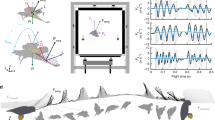Abstract
Most foot-propelled swimming birds sweep their webbed feet backwards in a curved path that lies in a plane aligned with the swimming direction. When the foot passes the most outward position, near the beginning of the power stroke, a tangent to the foot trajectory is parallel with the line of swimming and the foot web is perpendicular to it. But later in the stroke the foot takes an increasingly transverse direction, swinging towards the longitudinal axis of the body. Here we show that, early in the power stroke, propulsion is achieved mostly by hydrodynamic drag on the foot, whereas there is a gradual transition into lift-based propulsion later in the stroke. At the shift to lift mode, the attached vortices of the drag-based phase turn into a starting vortex, shed at the trailing edge, and into spiralling leading-edge vortices along the sides of the foot. Because of their delta shape, webbed feet can generate propulsive forces continuously through two successive modes, from drag at the beginning of the stroke, all the way through the transition to predominantly lift later in the stroke.
This is a preview of subscription content, access via your institution
Access options
Subscribe to this journal
Receive 51 print issues and online access
$199.00 per year
only $3.90 per issue
Buy this article
- Purchase on Springer Link
- Instant access to full article PDF
Prices may be subject to local taxes which are calculated during checkout



Similar content being viewed by others
References
Blake, R. W. Mechanics of drag-based mechanisms of propulsion in aquatic vertebrates. Symp. Zool. Soc. Lond. 48, 29–52 (1981)
Braun, J. & Reif, W.-E. A survey of aquatic locomotion in fishes and tetrapods. N. Jb. Geol. Paläont. Abh. 169, 307–332 (1985)
Johansson, L. C. & Lindhe Norberg, U. M. Asymmetric toes aid underwater swimming. Nature 407, 582–583 (2000)
Johansson, L. C. & Lindhe Norberg, U. M. Lift-based paddling in diving grebe. J. Exp. Biol. 204, 1687–1696 (2001)
Ellington, C. P., van den Berg, C., Willmott, A. P. & Thomas, A. L. R. Leading-edge vortices in insect flight. Nature 384, 626–630 (1996)
Katz, J. & Plotkin, A. Low-speed Aerodynamics (McGraw-Hill, New York, 1991)
Lee, M. & Ho, C.-M. Lift force of delta wings. Appl. Mech. Rev. 43, 209–221 (1990)
Thomas, A. L. R. On the aerodynamics of birds' tails. Phil. Trans. R. Soc. Lond. B 340, 361–380 (1993)
Norberg, R. Å. Swallow tail streamer is a mechanical device for self-deflection of tail leading edge, enhancing aerodynamic efficiency and flight manoeuvrability. Proc. R. Soc. Lond. B 257, 227–233 (1994)
Walker, J. A. QuickSAND. Quick Smoothing and Numerical Differentiation for the Power Macintosh 〈http://www.usm.maine.edu/~walker/software.html〉 (1997).
Acknowledgements
We thank B. Svensson for building the mechanical experimental device.
Author information
Authors and Affiliations
Corresponding author
Ethics declarations
Competing interests
The authors declare that they have no competing financial interests.
Rights and permissions
About this article
Cite this article
Johansson, L., Norberg, R. Delta-wing function of webbed feet gives hydrodynamic lift for swimming propulsion in birds. Nature 424, 65–68 (2003). https://doi.org/10.1038/nature01695
Received:
Accepted:
Issue Date:
DOI: https://doi.org/10.1038/nature01695
This article is cited by
-
The hydrodynamic performance of duck feet for submerged swimming resembles oars rather than delta-wings
Scientific Reports (2023)
-
Physical models and vortex dynamics of swimming and flying: a review
Acta Mechanica (2022)
-
Cormorant Webbed-feet Support Water-surface Takeoff: Quantitative Analysis via CFD
Journal of Bionic Engineering (2021)
-
Ear-body lift and a novel thrust generating mechanism revealed by the complex wake of brown long-eared bats (Plecotus auritus)
Scientific Reports (2016)
-
On the flow generated on the leeward face of a rotating flat plate
Experiments in Fluids (2013)
Comments
By submitting a comment you agree to abide by our Terms and Community Guidelines. If you find something abusive or that does not comply with our terms or guidelines please flag it as inappropriate.



